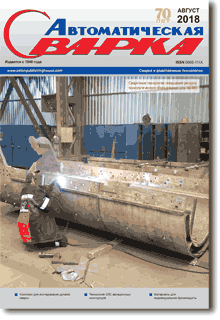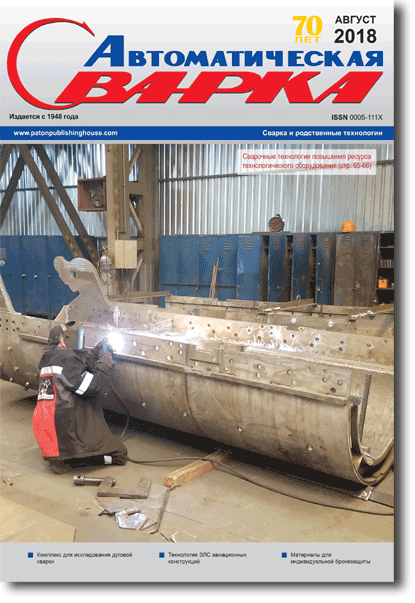| 2018 №08 (08) |
DOI of Article 10.15407/as2018.08.01 |
2018 №08 (02) |

Avtomaticheskaya Svarka (Automatic Welding), #8, 2018, pp. 3-7
Possibilities of nanomodification of dendrite structure of weld metal
V. V. Golovko
E.O. Paton Electric Welding Institute of the NAS of Ukraine. 11 Kazimir Malevich Str., 03150, Kyiv, Ukraine. E-mail:office@paton.kiev.ua
Abstract
Possibility of application of refractory disperses compounds for nanomodification of weld metal was shown. The results of calculation of the optimum size of modifier particles for weld pool conditions are given. Effect of the refractory particles on the parameters of weld metal primary structure was determined. Increase of dendrite size, noted as a result of addition into a weld pool of titanium carbide and zirconium oxide compounds, is accompanied by change of relationship between content of upper and lower bainite preserving fraction of martensite and xenomorphic ferrite. Indices of ductility as well as toughness of weld metal increase as a result. 14 Ref. , 4 Tabl. , 3 Fig.
Keywords: fusion welding; weld metal modification, nanodisperse particles, particle size, dendrite size, microstructure, mechanical properties
References
1. Goldshtejn, Ya.E., Mizin, V.G. (1986) Modification and microalloying of cast iron and steel. Moscow, Metallurgiya [in Russian].
2. Hashimoto, M. (2005) Advances in nano-level materials characterization technology. Nippon Steel Technical Report, 91(1), 2–6.
3. Suito, H., Ohta, H., Morioka, S. (2006) Refinement of solidification microstructure and austenite grain by inclusion particles. ISIJ Int., 46(6), 840–846. https://doi.org/10.2355/isijinternational.46.840
4. Davydov, S.V. (2006) Nanomodificator as a tool of genetic engineering of structural state of cast iron melt. In: Proc. of Casting Council No. 1 on Modification as an Effective Method for Improvement of Quality of Cast Irons and Steels. Chelyabinsk, Chelyabinsky Dom Pechati [in Russian].
5. Ryabtsev, I.A., Kondratiev, I.A., Gadzyra, N.F. et al. (2009) Effect of ultra-dispersed carbides contained in flux-cored wires on properties of heat-resistant deposited metal. The Paton Welding J., 6, 10–13.
6. Saburov, V.P., Eremin, E.N., Cherpanov, A.N., Minnekhanov, G.N. (2002) Modification of steels and alloys by disperse inoculants. Omsk, Izd. OmGTU [in Russian].
7. Bolshakov, V.I., Kalinin, A.V. (2016) Particularities of structure formation of modified Si–Mn steels. Stroitelstvo, Materialovedenie, Mashinostroenie, 89, 24–29 [in Russian].
8. Borisenko, V.E., Tolochko, N.K. (2008) Nanomaterials and nanotechnologies. Minsk, Tsentr BRU [in Russian].
9. Golovin, Yu.I. (2003) Introduction to nanotechnology. Moscow, Mashinostroenie [in Russian].
10. Bolshakov, V.I., Tushinsky, L.I. (2010) Structural theory of hardening of structural steels and other materials. Dniepropetrovsk, Svidler [in Russian].
11. Vanovsek, W., Bernhard, C., Fiedler, M., Posch, G. (2012) Influence of aluminum content on the characterization of microstructure and inclusions in high-strength steel welds. World, 57(1), 73–83.
12. Cherepanov, A.N., Afonin, Yu.V., Malikov, A.G., Orishich, A.M. (2008) About application of refractory compounds in laser welding and treatment of metals and alloys. Tyazholoe Mashinostroenie, 4/2, 25–26 [in Russian].
13. Grigoryan, V.A., Stomakhin, A.Ya., Ponomarenko, A.G. et al. (1989) Physicochemical calculations of electric steelmaking processes. Moscow, Metallurgiya [in Russian].
14. Erokhin, A.A. (1973) Principles of fusion welding. Physicochemical fundamentals. Moscow, Mashinostroenie [in Russian].
Received: 05.07.2018
Published: 19.07.2018.
The cost of subscription/purchase order journals or individual articles
| Journal/Currency | Annual Set | 1 issue printed |
1 issue |
one article |
| TPWJ/USD | 384 $ | 32 $ | 26 $ | 13 $ |
| TPWJ/EUR | 348 € | 29 € | 24 € | 12 € |
| TPWJ/UAH | 7200 UAH | 600 UAH | 600 UAH | 280 UAH |
| AS/UAH | 1800 UAH | 300 UAH | 300 UAH | 150 UAH |
| AS/USD | 192 $ | 32 $ | 26 $ | 13 $ |
| AS/EUR | 180 € | 30 € | 25 € | 12 € |
| SEM/UAH | 1200 UAH | 300 UAH | 300 UAH | 150 UAH |
| SEM/USD | 128 $ | 32 $ | 26 $ | 13 $ |
| SEM/EUR | 120 € | 30 € | 25 € | 12 € |
| TDNK/UAH | 1200 UAH | 300 UAH | 300 UAH | 150 UAH |
| TDNK/USD | 128 $ | 32 $ | 26 $ | 13 $ |
| TDNK/EUR | 120 € | 30 € | 25 € | 15 € |
AS = «Automatic Welding» - 6 issues per year;
TPWJ = «PATON WELDING JOURNAL» - 12 issues per year;
SEM = «Electrometallurgy Today» - 4 issues per year;
TDNK = «Technical Diagnostics and Non-Destructive Testing» - 4 issues per year.





